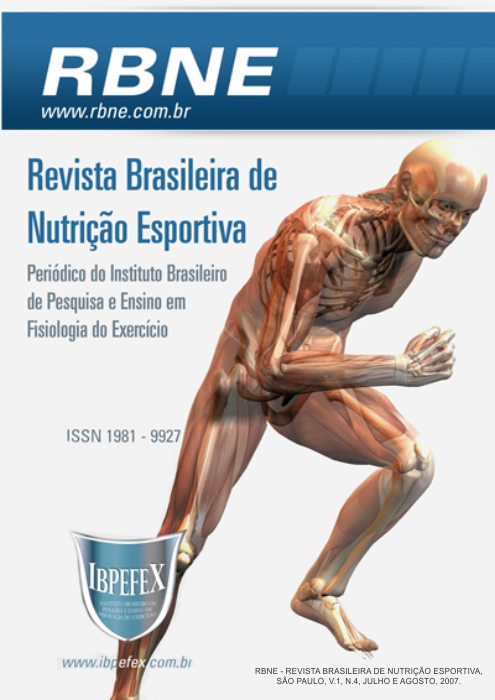Profile the frequency of alimentary comsumption of amateur athletes (street running)
Abstract
Although, in general, they are not submitted to one stress so physiological accented how much professional athletes, amateur athletes, certainly, need special attention with its feeding, since also she has the concern with the performance. The study it had as objective to evaluate the frequency of the alimentary consumption of resident running athletes of street in the city of Rio de Janeiro. Forty and three amateur corridors (26 men and 17 women) had answered a questionnaire contend information on volume and frequency of the training and feeding. The majority of the studied individuals (62.8%) showed a unsatisfactory number of meals (3-4 meals/day). Approximately half of the group presented adequate frequencies of consumption (4-7 times/week) of fruits,vegetables and leguminous (51.2%, 55.8%, 48.8%, respectively). The frequencies of alimentary consumption for the groups of cereals, meats and eggs, and milk and derivatives, had been adjusted (4-7 times/week) for most of the evaluated athletes (76.7%, 67.4% and 58.1%, respectively). Although the hídrico consumption has been satisfactory (8 cups/day) for the majority of the individuals (65.1%), the hydratation project still was insufficient for many individuals (34.9%). The results suggest that the nutritional orientation for a specialized professional is indispensable for the adequacy of the alimentary standard of the amateur athlete, what it can favor the attendance of the nutritionist demands in reply to the training.
References
American College of Sports Nutrition, American Dietetic Association, Dietitians of Canada. Joint Position Statement: nutrition and athletic performance. Medicine & Science in Sports & Exercise 2000; 32:2130-2145.
Camiña, S.M.; Kazapi, I.A.M. Avaliação do perfil nutricional e conhecimento de nutrição de atletas de voleibol. Nutrição em Pauta 2004; 69:20-24.
Carvalho, T.; Nóbrega, A.C.L.; Lazzoli, J.K.; Magni, J.R.T.; Rezende, L.; Drummond, F.A.; e colaboradores. Posição oficial da Sociedade Brasileira de Medicina do Esporte: atividade física e saúde. Revista Brasileira de Medicina Esportiva 1996; 2(4):79-81.
Carvalho, T. Diretriz da Sociedade Brasileira de Medicina do esporte – Modificações dietéticas, reposição hídrica, suplementos alimentares e drogas: comprovação de ação ergogênica e potenciais riscos para a saúde. Revista Brasileira de Medicina do Esporte 2003; 9(2): 43-56.
Coelho, C.F.; Sakzenian, V.M.; Burini, R.C. Ingestão de carboidratos e desempenho físico. Nutrição em Pauta 2004; 67:51-56.
Coyle, E.E. Fluid and carbohidrate replacement during exercise: how much and why?. Gatorade Sports Science Institute 1994; 50 (7), n.3.
Curi, R.; Lagranha, C.J.; Rodrigues, J.G.J.; Pithon-Curi, T.C.; Lancha, A.H.J.; Pellegrinotti, I.L.; e colaboardores. Ciclo de Krebs como fator limitante na utilização de ácidos graxos durante o exercício aeróbico. Arquivo Brasileiro de Endocrinologia e Metabolismo 2003; 47(2): 135-143.
Franco, V.M.F.; Manfroi, W.C. Ácidos graxos trans e a saúde cardiovascular. Nutrição em pauta 2005; 71: 37-43.
Gonzáles-Gross, M.; Guitiérrez, A.; Mesa, J.L.; Ruiz-Ruiz, J.; Castillo, M.J. La nutrición en la practica deportiva: Adaptación da la pirámide nutricional a las características de la dieta del deportista. Archivos Latinoamericanos de Nutrición 2001; 51(4)
Marquezi, M.L.; Lancha, A.H.J. Estratégias de reposição hídrica: revisão e recomendações aplicadas. Revista Paulista de Educação física, 1998; 12 (2):219-227.
McArdle, W.D.; Katch, F.I.; Katch, V.L. Nutrição Ideal para o exercício. In: Fisiologia do exercício. Rio de Janeiro: Guanabara Koogan, 2003: 83-106.
Mendes-Netto, R.S.; Burini, R.C. Efeito da oferta e do balanço de energia sobre o balanço protéico. Nutrire: Revista da Sociedade Brasileira de Alimentação e Nutrição 2000, 19/20: 129-144.
Oppligre, R.A.; Bartok, C. Hydration Testing of Athletes. Sports Medicine 2002; 32 (15):959-971.
Ravagnani, C.C.; Bastos, J.M.; Carolina, F.S.; Burini, R.C. Ergogênese nutricional dos lipídios e seus facilitadores metabólicos em exercícios prolongados.
Ryan, M. Complete guide to sports nutrition. Colorado: Velopress, 1999. 326p. 16- World Health Organization. Physical status: the use and interpretation of anthropometry. Report of a WHO Expert Committee. WHO Technical Report Series 1995, 854.
Authors who publish in this journal agree to the following terms:
- Authors retain the copyright and grant the journal the right of first publication, with work simultaneously licensed under the Creative Commons Attribution License BY-NC which allows the sharing of the work with acknowledgment of the authorship of the work and initial publication in this journal.
- Authors are authorized to enter into additional contracts separately for non-exclusive distribution of the version of the work published in this journal (eg, publishing in institutional repository or book chapter), with acknowledgment of authorship and initial publication in this journal.
- Authors are allowed and encouraged to post and distribute their work online (eg, in institutional repositories or on their personal page) at any point before or during the editorial process, as this can bring about productive change as well as increase impact and impact. citation of published work (See The Effect of Free Access).






